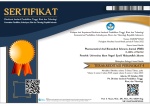Measuring Compliance Therapy in Type 2 Diabetes Mellitus Patients using Proportion of Days Covered (PDC) Method and Its Effect on Clinical Outcomes
Abstract
Keywords
References
Adikusuma, W. and Qiyaam, N. (2017) ‘ANTIDIABETIK ORAL TERHADAP KADAR HEMOGLOBIN TERGLIKASI ( HbA 1 c ) PADA PASIEN DIABETES MELITUS’, Jurnal Ilmiah Ibnu Sina, 2(2), pp. 279–286.
Almira, N., Arifin, S. and Rosida, L. (2019) ‘Faktor-Faktor yang Berhubungan dengan Perilaku Kepatuhan Minum Obat Anti Diabetes pada Penderita Diabetes Mellitus Tipe 2 di Puskesmas Teluk Dalam Banjarmasin’, Homeostasis, 2(1), pp. 9–12.
Astuti and Purnama, A. (2018) ‘Membaca Al-Quran Dapat Menurunkan Kadar Glukosa Darah pada Pasien Diabetes’, Jurnal Keperawatan, 000(99), pp. 479–486.
Atmaja, M. A., Diani, N. and Rahmayanti, D. (2017) ‘Evaluasi Cara Penggunaan Injeksi Insulin Pen Pada Penderita Diabetes Mellitus Di Rsud Ulin Banjarmasin’, Dunia Keperawatan, 5(1), p. 37. doi: 10.20527/dk.v5i1.3639.
Bell, K. F. et al. (2017) ‘Comparing Medication Adherence Glucose Cotransporter 2 Inhibitors with Type 2 Diabetes Using Sodium- and Persistence Among Patients or Sulfonylureas’, (June), pp. 165–174.
Bulu, A., Wahyuni, T. D. and Sutriningsih, A. (2019) ‘Hubungan Antara Tingkat Kepatuhan Minum Obat Dengan Kadar Gula Darah Pada Pasien Diabetes Melitus Tipe II’, Ilmiah Keperawatan, 4(1), pp. 181–189.
Carola, H. et al. (2016) ‘One-year Adherence to Oral Antihyperglycemic Medication and Risk Prediction of Patient Outcomes for Adults with Diabetes Melitus’, Medicine, 95(26).
Delvechia Agustin, L., Noor Istiqomah, I. and Mashuri (2022) ‘Manajemen Kadar Glukosa Darah Pasien Diabetes Mellitus Tipe 2 Melalui Puasa Ramadhan : Literatur Review’, Jurnal Kesehatan Komunitas Indonesia, 2(1), pp. 78–91. Available at: https://ebsina.or.id/journals/index.php/jkki.
Dewi, E. U. (2015) ‘Gambaran Faktor-Faktor Yang Mempengaruhi Terkendalinya Kadar Gula Darah Pada Pasien Diabetes Mellitus Di Puskesmas Pakis Surabaya’, Jurnal Keperawatan, 4(2). doi: 10.47560/kep.v4i2.143.
Febriyani, D. et al. (2021) ‘Profil Terapi Antidiabetes Oral Pada Pasien Diabetes Mellitus Tipe II Di Instalasi Rawat Jalan Rumah Sakit Anwar Medika’, Journal of Pharmaceutical Care Anwar Medika, 3(2), pp. 137–150. doi: 10.36932/jpcam.v3i2.71.
Gayatri, R. W. (2019) ‘Hubungan Faktor Riwayat Diabetes Mellitus Dan Kadar Gula Darah Puasa Dengan Kejadian Diabetes Mellitus Tipe 2 Pada Pasien Usia 25-64 Tahun Di Puskesmas Kendal Kerep Kota Malang’, Preventia : The Indonesian Journal of Public Health, 4(1), p. 56. doi: 10.17977/um044v4i1p56-62.
Hamarno, R., Nurdiansyah Z, M. and Toyibah, A. (2016) ‘HUBUNGAN ANTARA KEPATUHAN KONTROL DENGAN TERJADINYA KOMPLIKASI KRONIS PADA PENDERITA DIABETES MELITUS TIPE 2 DI PUSKESMAS JANTI KOTA MALANG Correlation on the compliance control with the chronic complication among diabetes mellitus type 2 at the Janti Com’, Ejournal.Umm.Ac.Id, 7(2), pp. 126–134. Available at: http://ejournal.umm.ac.id/index.php/keperawatan/issue/view.
Horii, T. et al. (2019) ‘Determination of factors affecting medication adherence in type 2 diabetes mellitus patients using a nationwide claim-based database in Japan’, PLoS ONE, 14(10), pp. 1–12. doi: 10.1371/journal.pone.0223431.
Lin, L. K. et al. (2017) ‘Medication adherence and glycemic control among newly diagnosed diabetes patients’, BMJ Open Diabetes Research and Care, 5(1), pp. 1–9. doi: 10.1136/bmjdrc-2017-000429.
Masruroh, E.- (2018) ‘Hubungan Umur Dan Status Gizi Dengan Kadar Gula Darah Penderita Diabetes Melitus Tipe Ii’, Jurnal Ilmu Kesehatan, 6(2), p. 153. doi: 10.32831/jik.v6i2.172.
Meta Srikartika, V., Akbar, M. R. and Nautika Lingga, H. (2019) ‘Evaluasi Intervensi Media Booklet Terhadap Tingkat Pengetahuan Dan Kepatuhan Pasien Diabetes Melitus Tipe 2 Di Puskesmas Banjarbaru Selatan’, Jurnal Publikasi Kesehatan Masyarakat Indonesia, 6(1), pp. 27–35. doi: 10.20527/jpkmi.v6i1.6874.
Milita, F., Handayani, S. and Setiaji, B. (2021) ‘Kejadian Diabetes Mellitus Tipe II pada Lanjut Usia di Indonesia (Analisis Riskesdas 2018)’, Jurnal Kedokteran dan Kesehatan, 17(1), p. 9. doi: 10.24853/jkk.17.1.9-20.
Ningrum, D. K. (2017) ‘Kepatuhan Minum Obat pada Penderita Diabetes MElitus Tipe II’, Higeia Journal of Public Health Research and Development, 1(3), pp. 84–94.
PERKENI (2021) Pedoman Pengelolaan dan Pencegahan Diabetes Melitus Tipe 2 Dewasa di Indonesia 2021, Pb Perkeni. Available at: www.ginasthma.org.
Prieto-Merino, D. et al. (2021) ‘Estimating proportion of days covered (PDC) using real-world online medicine suppliers’ datasets’, Journal of Pharmaceutical Policy and Practice, 14(1), pp. 1–14. doi: 10.1186/s40545-021-00385-w.
Rasmussen, J. B. et al. (2014) ‘Random blood glucose may be used to assess long-term glycaemic control among patients with type 2 diabetes mellitus in a rural African clinical setting’, Tropical Medicine and International Health, 19(12), pp. 1515–1519. doi: 10.1111/tmi.12391.
Soraya, I. A. et al. (2022) ‘The Association between Adherence to Oral Antihyperglycemic Agent and HbA1c Level’, Pharmaceutical Sciences and Research, 9(2), pp. 93–101. doi: 10.7454/psr.v9i2.1260.
Swe, K. and Reddy, S. S. K. (2020) ‘Improving Adherence in Type 2 Diabetes’, Clinics in Geriatric Medicine, 36(3), pp. 477–489. doi: 10.1016/j.cger.2020.04.007.
Yanto, A. and Setyawati, D. (2017) ‘Dukungan Keluarga Pada Pasien Diabetes Mellitus Tipe 2 Di Kota Semarang’, (September), pp. 45–49.
DOI: 10.15408/pbsj.v6i1.37761
Refbacks
- There are currently no refbacks.






